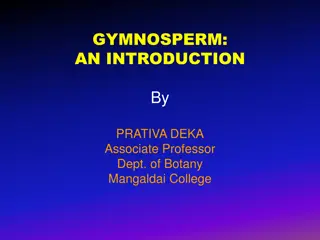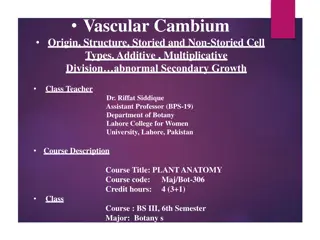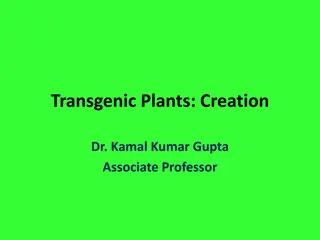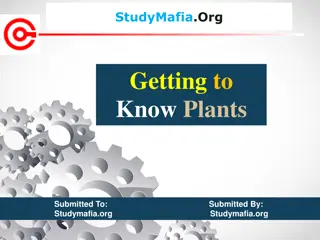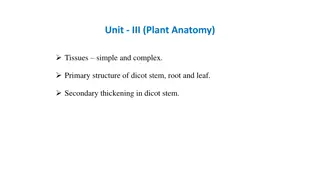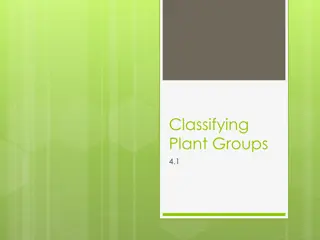Various Types of Stems in Plants - A Visual Guide
Culms, pseudostems, weak stems, and more - explore the diverse forms of plant stems such as jointed culms in bamboos, unbranched aerial shoots in onion and garlic, and creeping stems like runners and stolons. This visual guide showcases the unique characteristics of different plant stems with detailed descriptions and images.
Download Presentation

Please find below an Image/Link to download the presentation.
The content on the website is provided AS IS for your information and personal use only. It may not be sold, licensed, or shared on other websites without obtaining consent from the author.If you encounter any issues during the download, it is possible that the publisher has removed the file from their server.
You are allowed to download the files provided on this website for personal or commercial use, subject to the condition that they are used lawfully. All files are the property of their respective owners.
The content on the website is provided AS IS for your information and personal use only. It may not be sold, licensed, or shared on other websites without obtaining consent from the author.
E N D
Presentation Transcript
Culms are jointed stems with solid nodes and hollow internodes. This can be found in the bamboos e.g. Bambusa vulgaris.
unbranched aerial shoot bearing either a single or a cluster of flowers, such flowering shoot is called scape. Examples can be found in onion (Allium cepa), garlic (Allium sativum )etc.
Pseudostem is a stem formed by the joining together of the leaf bases of several leaves of theplant e.g. Banana and plantains (Musa sp.), Ensete gilleti etc.
Plants with weak stems could be either trailers, creepers, climbers, twinners, lianas, stranglers or scramblers.
procumbent or prostrate (when the stem lies flat or run parallel to the ground) e.g. Indigofera sp., Oxalis sp. etc. or Decumbent (when the tip of the stem is raised) as in Tridax procumbens or Diffuse (when the stem branches spread out in all directions) as in Boerhaavia sp.
Creeping stems could be runners, stolons or offsets. Each of the rooted node with shoot can become independent plants if the linking stems (internodes) are cut. Creeping plants could be runners, stolons or offsets.
Runners are creeping stems with long and slender stems that run parallel to the ground surface e.g. Cucurbita sp., Lagenaria sp., Telfaria occidentalis etc.
portion of the stem between two adjacent nodes raised from the ground surface i.e. the internode does not lie flat on the ground e.g. Fragaria indica, wild strawberry etc.
Offsets are similar to runners, but the internodes in offset are shorter and stouter than those in runners e.g. water lettuce (Pistia sp.,) water hyacinth (Eichhornia sp.).
plant or object, often by means of some special devices and climb the support to a long or short distance. Different kinds of climber are known, depending on their devices or means of climbing. Examples are:
Hook climbers e.g. Bougainvillea sp., Rose (Rosa sp)
Stem tendril climbers e.g. Passiflora edulis, Telfaris occidentalis
Root climbers e.g. Piper betle, Piper guinensis etc.
herbaceous plants with weak stems that climb other plants or objects without any device or means of climbing. They twine round their supports, e.g. Yams (Dioscorea sp) Ipomoea.
Lianes/Lianas are perennial plants with woody climbing stems e.g. Entada gigas, Alafia barteri
Other forms of plants with weak stems are scramblers and stranglers.
themselves to their supports, but they simply lean against nearby plants or any other support and spread over them e.g. Combretum sp.
host or near the host. They produce short and root systems which grow round the host or support and may later kill the host or support by strangulation e.g. Ficus sp.
and perennation. They are usually dormant during unfavourable season but give off aerial shoots annually under favourable conditions. They are always thick and fleshy, having deposit of reverse food materials in them.
the surface of the soil. It has distinct nodes and internodes. Roots and scaly leaves are produced as their nodes. Rhizomes bear terminal and axillary buds which give rise to new aerial shoots during favourable periods.
with stored food substance as in the aligator pepper (Aframomum canna), ginger (Zingiber officinarum) or slender as in grasses such as the spear grass (Imperata cylindrical).
grow up into new plants. Tubers are often very much swollen, becoming almost spherical and they usually occur singly. Examples of tubers are sweet potato (Ipomoea batata), yams (Dioscoroea sp.), Irish potato (Solanum tuberosum), Tiger nut (Cyperus esculentum) etc.
leaves. The scale leaves grow from the upper surface of the stem or around it while a cluster of fibrous roots grow from the base of the stem. The fleshy scale leaves store food while the dry outer scale leaves give protection. The bulb grows in vertical direction.
may also be produced in the axils of the fleshy scale leaves. These may develop into aerial shoots and finally form daughter bulbs. Examples are the common onion (Allium cepa), garlic (Allium sativum).
bears buds in the axils of the scale leaves and some of these bud give rise to daughter corms. Adventitious roots develop from the base and sometimes also from the sides e.g. cocoyam (Xanthosoma sagittifolia), taro (Colocasia esculentum).
horizontally outwards under the ground and later upwards and directly gives rise to a leafy shoot or a new plant. The sucker may be short and stout as in banana (Musa sp.), pineapple (Ananas sp.,) bamboo (Bambusa vulgaris) etc.
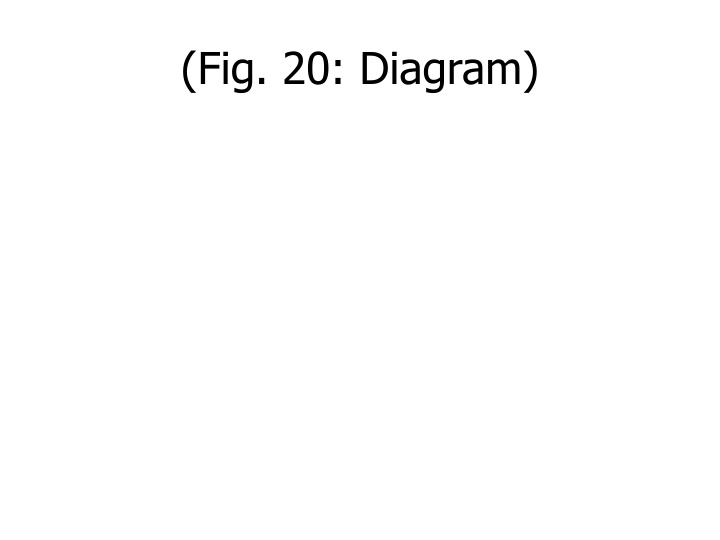

![textbook$ What Your Heart Needs for the Hard Days 52 Encouraging Truths to Hold On To [R.A.R]](/thumb/9838/textbook-what-your-heart-needs-for-the-hard-days-52-encouraging-truths-to-hold-on-to-r-a-r.jpg)
